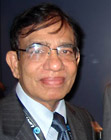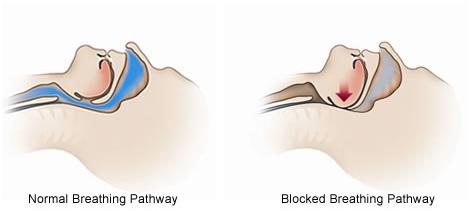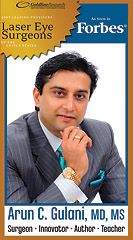
Do you snore? Part II
The problem of Sleep Apnea, a serious disorder

Getting adequate and comfortable sleep is necessary for good health. We are a driven society, over-stimulated by so many new gadgets such as Internet, smart phones, loud music, drug abuse, fast living, etc. Insomnia, defined as inadequate sleep, lack of good quality sleep or difficulty in falling asleep or waking up too early and then getting back to sleep, is quite common. Hence, good sleep is needed for restoration of health.
Sleep apnea, as I mentioned earlier, is one of the most common and serious of all sleep disorders in America and ruins the sleep of many among us. There are two types: Central Sleep Apnea that occurs with certain diseases such as heart failure or stroke. The Obstructive Sleep Apnea commonly referred as OSA is the widely prevalent and the most dangerous one that can affect anybody. Here are the stats:
-
1 in 5 adults suffer from some form of OSA.
-
More than 1 in 2 people with type 2 diabetes have sleep apnea.
-
8 out of every 10 people who have sleep apnea have not been diagnosed for it.
Mechanism of sleep apnea
A quick lesson in the anatomy and physiology of breathing and the air flow in the neck. As you start becoming drowsy at the onset of sleep, the muscles of the soft palate become weaker, allowing it to sag and air passages are obstructed leading to snoring. Next the contraction of the diaphragm, a vital element in inspiration, gets inhibited because of reduced signals from the brain that results in shallower breathing. This drops the blood oxygen levels and when it reaches a critical level, physiological damage can occur in many areas of the body. But there is a built- in safety backup mechanism that stimulates the brain at this point to order the body to take a large and deep inhalation and the patient then wakes up with a snort. As you drift off to sleep again, the process is repeated. The following diagram is self-explanatory.

Consequences of sleep apnea
There are major health hazards that accompany OSA, apart from the symptoms mentioned earlier.
-
Fatigue and sleepiness during waking hours. Driving can be hazardous and 8,000 deaths annually are attributed to sleeping on the wheel! Something to think about?
-
Hypertension : According to a study published in the Archives of Internal Medicine, middle-aged "adults who routinely get fewer than seven to eight hours of sleep a night may be at risk for developing" hypertension. In fact, "for every hour less of sleep, the odds of developing the condition rose an average 37 percent over five years," and "for every two hours less, there was an average of 86 percent increased risk for the same.
-
Reduced immunity that makes you susceptible for frequent infections
-
Hormone imbalance: Diabetes tends to be common because of decreased insulin resistance.
-
Obesity common with insomnia and sleep apnea: Unfortunately, this becomes a vicious cycle perpetuating each other.
-
Cardiovascular diseases, including coronary artery disease and strokes, also occur more frequently. Heavy snoring significantly increases the risk of carotid atherosclerosis, a major risk factor for strokes. Same goes with serious cardiac arrhythmias.
-
Toddlers who snore, are likely to show many behavioral disorders as they get older according to a study from Southwestern England. These children, 5-7 years old, showed hyperactivity, aggression, anxiety and depression.
Who are at risk for sleep Apnea?
Sleep apnea can affect anyone at any age, even children. Risk factors for sleep apnea include:
-
Male gender
-
Obesity and overweight
-
Aging - Over the age of 40
-
Large neck size (>17 inches in men and >16 inches in women)
-
Throat problems: large tonsils, large tongue, or a small jaw bone
-
Family history of sleep apnea
-
Gastroesophageal reflux( GERD)
-
Nasal obstruction from deviated septum, allergies, or sinus problems
So, learn more about healthy sleep and take measures to treat sleep apnea.
To be continued …
Dr. M. P. Ravindra Nathan is a Brooksville cardiologist.
GUEST COLUMN
SUMMER TIME AND RED EYES: PROTECT YOUR EYES TOO, NOT JUST YOUR SKIN

As spring and summer approach, we are constantly warned about the dangers of increased sun exposure. Dermatologists caution us about melanoma. Doctors urge us to remain hydrated during outdoor activities but there is not much a hue about another distressful condition that increases in incidence with sun exposure – Pterygium.
Increased and consistent sun exposure, especially in tropical and sub-tropical climates, can lead to an eye condition where a yellow-red lesion called pterygium can appear and progress on the white of our eyes.
Pterygium, pronounced “terigeeum,” is a raised, wedge-shaped growth of the conjunctiva (transparent saran-wrap like layer covering the white of our eyes. This layer when infected causes the pink eye or conjunctivitis) which starts with a cosmetically unappealing, constantly red eye with symptoms of irritation, redness and even tearing.
It is fairly common among sports and recreation enthusiasts, golfers, surfers, as well as outdoor workers. Although it often remains dormant and mostly a cosmetic blemish with embarrassingly red and unhealthy looking eyes, it can be a relentless disorder, growing across the cornea and adversely affecting vision.
As pterygium develops, it affects vision in two ways: one, by directly acting as a scar and two, by altering the shape of the cornea and thereby even affecting vision.
Medical treatments for this condition are varied and far flung, all evidence to the fact that none of them work. Surgery has been the mainstay for this problem.
I do believe that most cases of pterygium are associated with dry eyes and as we had mentioned in our previous article, the dry eye needs to be treated with artificial tears, lacrimal plugs and medications such as Restasis eye drops.
Surgery for pterygium though is complicated by the fact that there is a high rate of recurrence of this lesion and also sometimes a scar that could look worse after surgery.
Breakthrough techniques and technologies to address this condition, which is rampant in the Florida climate, include the use of human placenta wherein after removing the lesion during surgery, a human amniotic graft (derived from human placenta that is tested to be disease free) is applied to the area of surgery and this technique is further raised by using Tissue glue instead of stitches, resulting in not only an excellent surgical outcome but an outstanding cosmetic appearance, including a lower rate of recurrence.
Additionally, Advanced Laser Vision surgery and Lasik can be performed on such patients to further make them see without glasses or contact lenses in keeping with my philosophy of “ Look Good and See Good.”
Even with such surgical advances and pharmaceutical landmarks, I believe that prevention is still the best medicine.
Since pterygiums are most commonly caused by sun exposure, protecting the eyes from sun, dust and wind is recommended, including wearing good sunglasses with UV protection.
So, in summer, we must protect our skin but do not forget to bring your hats, wetting drops and wrap around, UV blocking sunglasses to the beach.
Arun C. Gulani, M.D., M.S., is director and chief surgeon of Gulani Vision Institute in Jacksonville. He can be reached at [email protected] or visit www.gulanivision.com